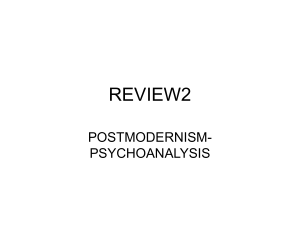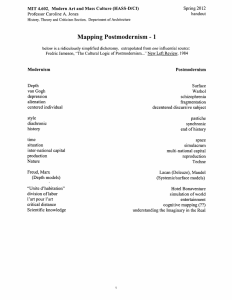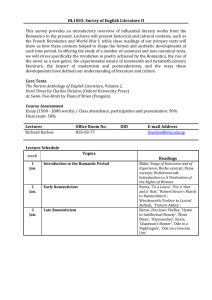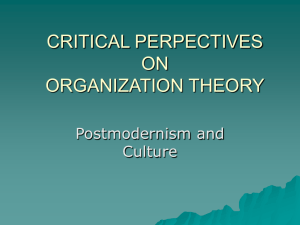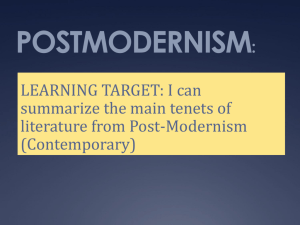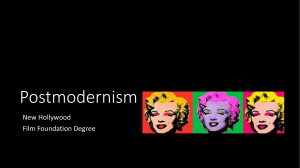Postmodernism
advertisement
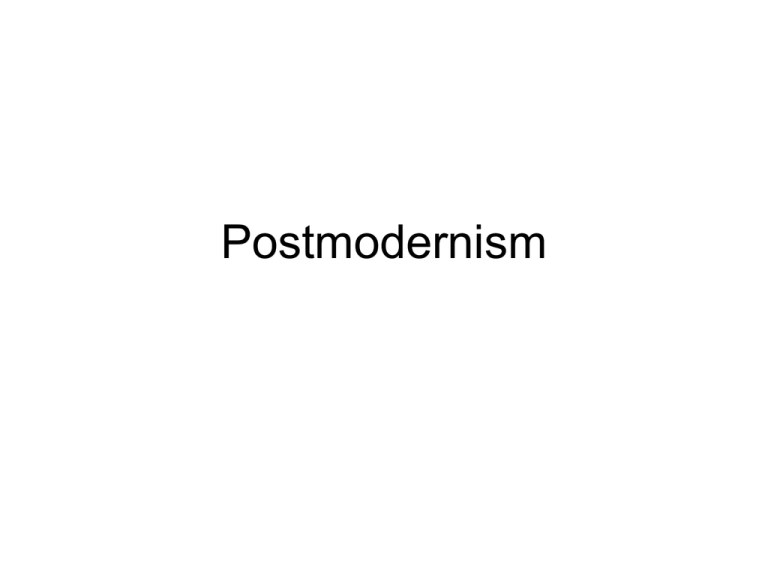
Postmodernism • According to Sarup, poststructuralists like Foucault, Derrida, and Lyotard are postmodernists • There are similarities between poststructuralist theories and postmodernist practices that it is difficult to make a clear distinction • Postmodernism is a set of ideas and has only emerged as an area of academic study since the mid-1980s although it’s not clear exactly when postmodernism begins • Thinking about postmodernism is thinking about modernism, the movement from which postmodernism seems to grow or emerge. • Modernism is the movement in visual arts, music, literature, and drama which rejected the old Victorian standards of how art should be made, consumed, and what it should mean. The main characteristics of modernism • An emphasis on impressionism and subjectivity in writing. • A movement away from the apparent objectivity provided by omniscient thirdperson narrators, fixed narrative points of view, and clear-cut moral positions. • A blurring of distinctions between genres, so that poetry seems more documentary. • An emphasis on fragmented forms, discontinuous narratives, and randomseeming collages of different materials. • A tendency toward reflexivity, or selfconsciousness, about the production of the work of art, so that each piece calls attention to its own status as a production, as something constructed and consumed in particular ways. • A rejection of elaborate formal aesthetics in favor of minimalist designs, and a rejection, in large part, of formal aesthetic theories, in favor of spontaneity and discovery in creation. • A rejection of the distinction between “high” and “low” or popular culture, both in choice of materials used to produce art and in methods of displaying, distributing, and consuming art. • Postmodernism, like modernism, follows most of those same ideas, rejecting boundaries between high and low forms of art, rejecting rigid genre distinctions, emphasizing pastiche, parody, bricolage, irony, and playfulness. • Post modern art (and thought) favors reflexivity and self-consciousness, fragmentation and discontinuity (especially in narrative structures), ambiguity, simultaneity, and an emphasis on the destructured, decentered, dehumanized subject • But—while postmodernism seems very much like modernism in these ways, it differs from modernism in its attitude toward a lot of these trends. Modernism tends to present a fragmented view of human subjectivity and history, but presents that fragmentation as something tragic, something to be lamented and mourned as a loss. • Postmodernism, in contrast, doesn’t lament the idea of fragmentation, provisionality, or incoherence, but rather celebrates that. • Totality and stability and order, Lyotard argues, are maintained in modern societies through the means of “grand narratives” which are the stories a culture itself about its practices and beliefs. Every belief system or ideology has its grand narratives, according to Lyotard • Lyotard argues that all aspects of modern societies, including science as the primary form of knowledge, depend on these grand narratives. Post modernism then is the critique of grand narratives, the awareness that such narratives serve to mask the contradictions and instabilities that are inherent in any social organization or practice. • Postmodernism is concerned with questions of organization of knowledge. • In a postmodern society, knowledge becomes functional—you learn things, not to know them, but to use that knowledge. • Postmodernism seems to offer some alternatives to joining the global culture of consumption, where commodities and forms of knowledge are offered by forces far beyond any individual’s control. These alternatives focus on thinking of any and all action (or social struggle) as necessarily local, limited, and partial—but nonetheless effective. • By discarding “grand narratives” and focusing on specific local goals, postmodernist politics offer a way to theorize local situations as fluid and unpredictable, though influenced by global trends.
